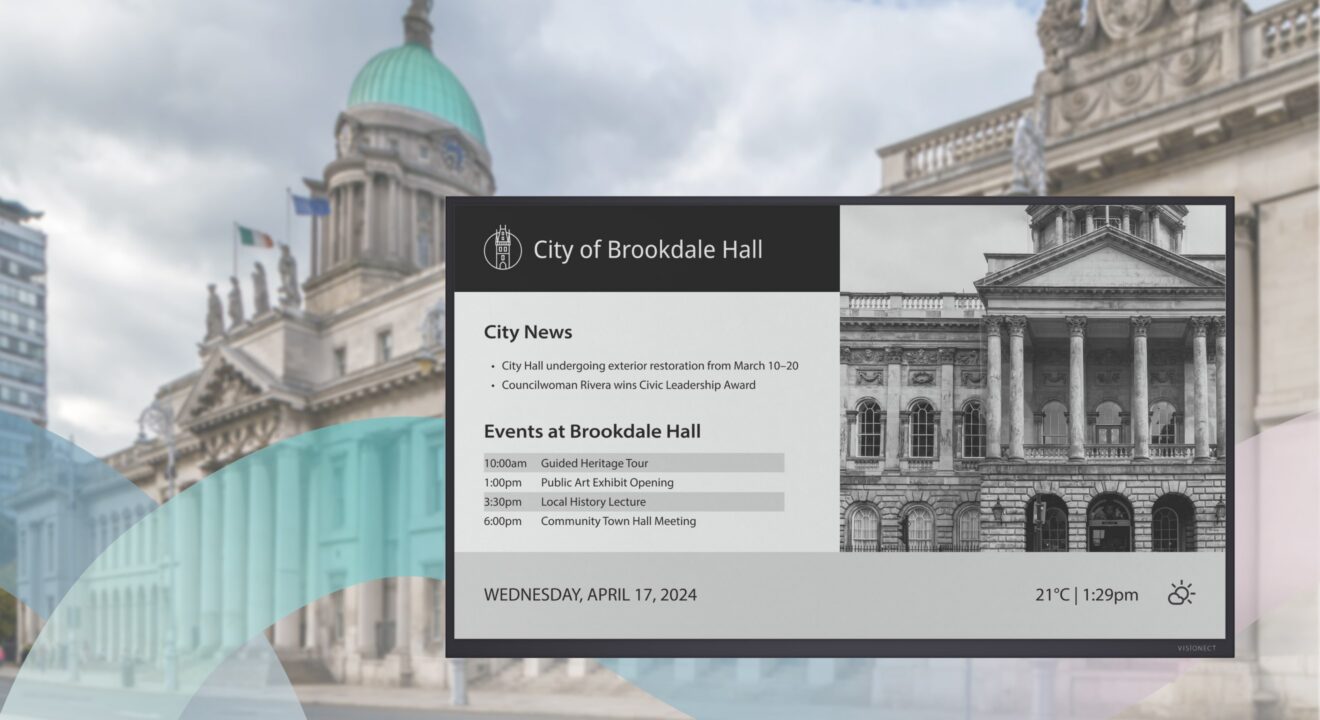

Why heritage buildings need wireless digital signage
Visionect, 11 Nov 2025
Heritage buildings are a delicate mix of history, architecture, and culture. From centuries-old churches to historic city halls, these spaces must share information with visitors while protecting their walls and interiors. Sleek, battery-powered, and easy to update, e-paper displays offer a solution that respects the past while meeting the needs of today, without drilling holes or running wires.
Bringing information to life in historic sites
E-paper is quietly reshaping how historic sites share information. These displays look just like printed paper but offer the convenience of modern technology. The text stays crisp and easy to read, with no glare or flicker. Staff can update content remotely, whether they’re adjusting visiting hours or adding a new exhibit note. All of this happens while keeping the building’s original walls and finishes perfectly intact.
And it’s not just about looks. E-paper is remarkably energy-efficient, using power only when the screen changes. The batteries can last for months, even in places where plugging in a screen simply isn’t an option. They also operate in complete silence, helping preserve the calm, contemplative atmosphere that makes these historic spaces so special.
Let’s take a look at how e-paper can be used in different types of historic buildings.
Churches and places of worship
Churches and chapels are living heritage sites, often hundreds of years old, yet still hosting daily services, concerts, and community events. Any signage must be enlightening without disrupting the space’s atmosphere. This dual purpose makes signage challenging…
Wireless e-paper displays are ideal in these use cases. Medium-sized devices like the Visionect Place & Play 13″ can show service times, choir schedules, and special event notices. QR codes for donations or audio guides can be elegantly displayed without taping posters to heritage doors or walls. Multilingual panels allow churches to welcome international visitors, and freestanding e-paper stands can guide tourists through chapels or exhibitions without cluttering historic interiors.
Discover the best digital signage software for churchesCivic and government buildings
Historic city halls, courthouses, and council chambers are still in use today, but their beautiful architecture can make modern signage tricky. E-paper offers a simple solution, giving visitors clear, easy-to-read information while keeping marble staircases, wooden paneling, and ornate stonework just as they were meant to be.
For example, Place & Play 13″ displays outside council chambers can show meeting schedules and room bookings, updated automatically from a central CMS. High-contrast panels make information accessible for all visitors, and temporary event wayfinding ensures that weddings, conferences, and public hearings run smoothly without obtrusive floor signs or tape on walls.
Museums and galleries
Museums housed in historic buildings face strict conservation rules, limited wall space, and power restrictions. E-paper is a natural fit. Small Place & Play 6″ displays can provide labels for individual artifacts, while larger 13″ panels can showcase extended information, translations, or high-resolution images.
Dynamic labels allow curators to rotate exhibit content, update interpretations, or add multilingual support without reprinting materials. Temporary exhibitions benefit as well: the displays can move from one gallery to another effortlessly, with content updated remotely.
For example, Leicester Museums and Galleries use Visionect’s e-paper displays to create interactive, sustainable labels that showcase visitor insights, rotate exhibit content, and provide multilingual information across multiple historic sites.
Castles and historical landmarks
Historic castles, palaces, and stately homes often have large, intricate interiors where visitors need guidance and context, but walls, paneling, and decorative features can’t be altered. Wireless e-paper displays are the perfect solution for these indoor spaces. Visionect’s Place & Play 32“ screens provide large, readable signage that can show detailed historical information, artwork descriptions, or visitor directions without ever drilling or wiring into the building.
These displays allow curators to rotate content, from architectural details and room histories to exhibit highlights or event schedules. QR codes can be added for deeper engagement, giving visitors access to audio tours or multimedia content on their devices, keeping the room free of bulky posters or printed sheets. By blending unobtrusively with interiors, e-paper signage preserves the elegance and historical integrity of every space.
Design tips for heritage settings
Adding e-paper displays to historic interiors takes a bit of planning, but it’s worth it to make sure the signage is helpful for visitors while still respecting the building’s character. Here are a few things to keep in mind:
- Damage-free installation. Use adhesive pads or freestanding stands so displays can be removed without damaging walls or fixtures.
- Harmonious finishes. Choose frames and mounts that complement wood, stone, metal, or other historic interior elements.
- Environmental suitability. Ensure displays can handle indoor temperature fluctuations and humidity.
- Maintenance access. Even long-lasting batteries need to be recharged every few months. So, position screens where staff can reach them safely.
- Content flexibility. Plan layouts and sizing appropriate for visitor sightlines and reading distances to ensure clarity without overwhelming historic spaces.
Sustainability and efficiency
E-paper signage isn’t only beautiful, but is practical to boot. Heritage sites save time and resources because there’s less printing and paper waste, and staff can update labels quickly without running around multiple locations. Plus, e-paper uses very little energy compared to traditional screens. With centralized content management, multiple displays across a site (or even several buildings) can be updated all at once, helping historic spaces share information in a modern, effortless way.
Wrap up: Modern communication in timeless spaces
Wireless e-paper displays like Visionect’s Place & Play models bring modern functionality into historic buildings in a way that’s elegant, sustainable, and completely reversible. From churches to museums, city halls to castles, these displays offer stylish, dynamic, and accessible signage all with minimal energy use, making them as kind to the environment as they are to history.
Discover how to share a story without leaving a mark on history.
CONNECT WITH A VISIONECT MEMBER TODAY
